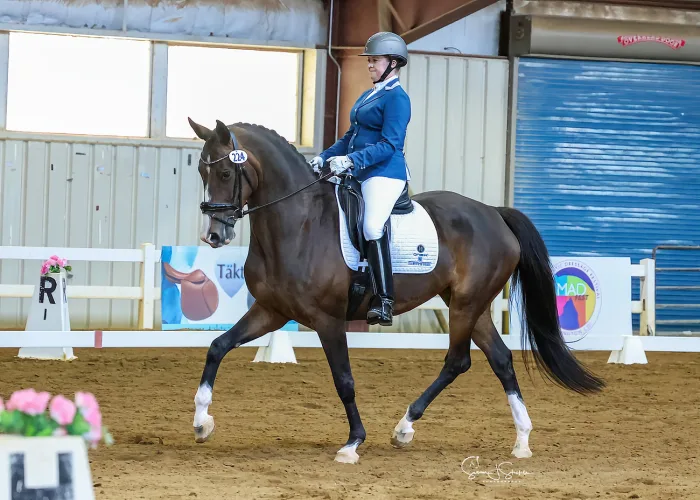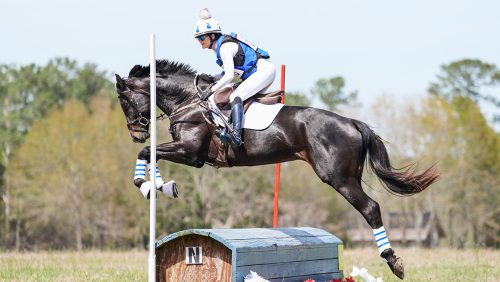Dogs, horses, humans—we’re all malleable, but never more than as youngsters. Our early years are so terribly critical. It’s why the folks who take Thoroughbreds off the track, or who fetch neglect cases from the auction, and make them into good citizens in sport disciplines are really so extraordinary. It’s much easier to teach something well the first time than it is to install it as an after-market add-on.
As a horse person who generally has had enough money to get nice young things but not nicely trained things, this has worked out fine for me. I was never someone who started babies, but even getting them at 3 and 4, and immediately thinking about turning nicely, adjusting nicely, taking my big ol’ leg and big ol’ seat, and generally fitting into my program and my style from the beginning means that becomes their native tongue. They are imprinted into my way. My way works well for me, and thus far has produced lots of horses that are both good at dressage and good at life. These horses also seem to do well in their next homes, even ones with people shaped differently than me, or who ride differently than me. That’s lovely. And I’m not unique in this—most dressage trainers follow the German Riding System of leg-seat-hand because it works. Most trainers install things like ground manners and standing at the mounting block and going away from home like a good boy instead of like a feral beast because most trainers don’t want to die.

But there are also things I think about, even at 3 and 4, that I know will serve my horses well as potential Grand Prix horses down the road. And they’re not things that are big and hairy and filled with pressure; I’m not piaffing 4-year-olds or schooling canter pirouettes on babies. But I’m thinking about their Big Ring futures as I develop basic concepts, and I keep the Grand Prix in my training level work. For most of my horses, who are modern warmbloods purpose bred for sport, that’s putting the focus on small. Shrinking their lateral and longitudinal balance, focusing more on engagement than on big gaits, focusing on core strength, and doubling down on the tools that may not win at the lower levels, but will prove to be exactly what the doctor ordered down the road at Grand Prix.
For Madiene, my 6-year-old Dutch Warmblood mare (Toto Jr—Adiene, Don Primaire), who’s been in my life since she turned 4, that’s been my daily modality. “Maddie” is a lot of lady—17.3 hands and long—with a little bit of a curvy, weak low back from nature, and plenty of go. My focus has been adjustability, particularly in the direction of smaller steps, and building topline to strengthen and protect that imperfect low back conformation. Am I doing that through actual half-steps, the first process of piaffe? Not at 4 and 5. Instead, in those years, I’d just tease the trot back to almost walk, and then ooze back out to normal working trot again, about a million times a ride. Maddie is 6 now, and I’ve started incorporating using my stick lightly atop her croup to help her think about lowering it, bending her hocks and stifles under the body a bit more, but it’s casual and playful, an easy place to go to. She’s comfortable there, comfortable with the pressure, and being in that nice little bouncy round shape is her native tongue. And she also feels like MY ride, because she has been MY ride for two full years.
The Elvis Syndicate’s new horse, 7-year old Danish Warmblood gelding C. Cadeau (St. Schufro—C. Chanel, Richman), wasn’t developed like this. He and Maddie have some commonalities: big, powerful gaits; a fantastic bend to the hind leg; and being just a little bit long-bodied. Cadeau is also whip smart, and he learned a lot of exercises before coming to me. He’s got a lovely flying change, an absolutely absurd ability for canter pirouettes, and is also much further along than Maddie is in his lateral flexibility, so he bends better. But for me, his idea of collection doesn’t feel like I want it to feel.
Let’s be clear: I’ve ridden Cadeau for about six weeks as I write this, much of which was spent getting weight back on after his importation, dealing with the case of Hives to End All Hives because an American insect had the audacity to touch him and all hell broke loose for a week or so, and dealing with the inevitable abscess/foot hiccups of going from a lifetime on nice, soft, squishy European soil to the concrete block that is Virginia in the summer. I’ve seen this all before with the imports, and it’s long since stopped scaring me (though I did think he’d broken his leg when he came in with the abscess… yikes). And it’s why I giggled when one of his amazing owners asked me, “So when’s your first show?” LOL—2024, maybe?
ADVERTISEMENT
Showing isn’t where my energy goes, at this point in their lives. I will be taking him to a show at some point this year, but not for glory, just for the next rung on the “getting to know you” ladder. That experience should help answer questions about, “Are you a fruit loop at shows?” (I doubt it, but you never know ’til you know), or, “Do you need the work the day before we go, or do you need a day off so you’re not flat on Sunday?” And on, and on.
My focus this year is getting him as imprinted into my preferred outline as I can. I’m diligently and consistently doing the same boring little work that Maddie’s been doing from a 4-year-old.
I’m hitting some obstacles: Cadeau answers my call for small trot by either walking, or by pushing his hind legs backwards and powering around in a slower rhythm. Cadeau answers my requests for a lower neck by sending all his energy onto his forehand and into his underneck, rather than just using his back differently. But I’m also making progress, in spite of the hives and the foot stuff and the “what saddle do I ride this horse in because he’s a different shape every day.” But installing these concepts aftermarket is different. They will be his second language, and for a while, everyone’s more awkward in their second language.
This is why people who catch ride impress me so much. Maybe it’s easier than I think—having never been handed the keys to a Grand Prix horse, I don’t have a comparison point—but I doubt it. That’s a lot of fine controls to learn to speak like someone else.
There are many reasons I fell in love with Cadeau, one of them being that he reminded me a lot of my former Grand Prix partner Elvis at this age.
Elvis, too, had learned a hell of a lot of the things, so many that he’d competed at the FEI 7-Year-Old level—basically a baby Prix St. Georges test—and been long-listed for the Dutch team to the World Championships. But he didn’t feel like he had the hind leg I wanted yet, and he actually had a bit of a violent response to the idea of being closed up in the trot for a while. But I persisted, quietly and annoyingly, and over time, the small trot he’d been convinced was a non-starter at 7 became a highlight piaffe. But it required my full attention, tons of patience, and a long time of not being caught up in national-level victories (or a lack thereof).
ADVERTISEMENT
Maddie is showing first level at age 6, an age at which the FEI tests call for collection, mid-level lateral work and single flying changes. I don’t think those are unreasonable things to visit for most horses who’ve been started at the typical age of 3 or so, and who’ve been in uncomplicated and correct basic work from that point. I also don’t think that the genius horses, the ones who are genetic prodigies and figure out how to do that type of work with ease, are doomed to a life of lameness and disaster. I’ve visited the changes with her; they’ve been uncomplicated, so I’ve largely left them alone. I’ve introduced half-steps; she won’t find them hard, so I’ve kept the concepts very basic, and spent very little time on them. And I’ve absolutely made sure she understands throughness, roundness and responsiveness to the aids. We’re not lollygagging around, and I don’t believe at all the nonsense that makes its way around the internet from time to time that, because the joints don’t close until 6, we’re cruel for even riding them before then. It’s much easier and safer and kinder for everyone involved that young horses learn to accept age-appropriate pressure.
The balancing act we’re all trying to strike, at least those of us doing it well, is between enough pressure, and in a Grand Prix sort of way, that they never learn any other shape, and then just not spending a huge amount of time there. We’re navigating how to ask for training level things in a Grand Prix way.
Of course my young horses are going to answer questions like young horses do: imperfectly, sometimes without enough power, sometimes too low in the neck for want of more strength and balance, sometimes not prompt enough. My expectations are age appropriate, and I don’t hammer away on things, either. I care about rewarding effort more than excellence, so they learn to love trying. But I’m keeping that Big Ring goal in mind, even from an early age, so it’s their mother tongue.
Lauren Sprieser is a USDF gold, silver and bronze medalist with distinction making horses and riders to FEI from her farm in Marshall, Virginia. She’s currently developing her and Mary Ewing’s Gretzky RV, as well as her own string of young horses with hopes of one day representing the United States in team competition. Follow her on Facebook and Instagram.














